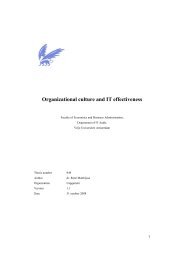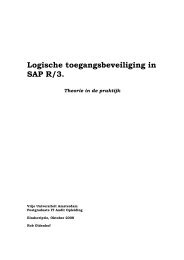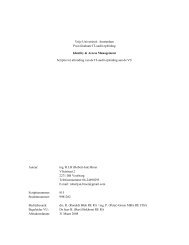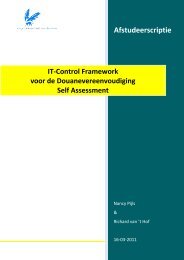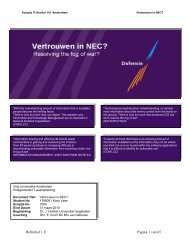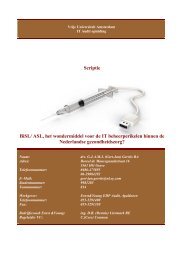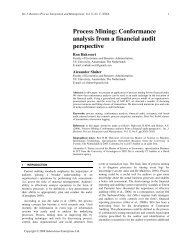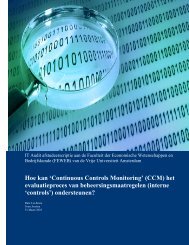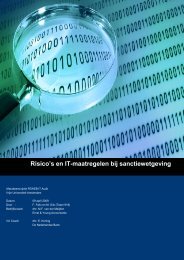Usability and Security
Usability and Security - Vurore
Usability and Security - Vurore
You also want an ePaper? Increase the reach of your titles
YUMPU automatically turns print PDFs into web optimized ePapers that Google loves.
<strong>Security</strong> aspects:• Confidentiality: in this aspect the property that information is not made available to unauthorizedindividuals is important. When a token gets lots or stolen, the risk of unauthorized individualsgetting access to a building increases. In the case of an OTP, an unauthorized user would stillrequire the key fob <strong>and</strong> userid to obtain remote access. This aspect is therefore considered whenusing OTP;• Integrity: in this aspect the property of safeguarding the accuracy <strong>and</strong> completeness of assets isimportant. When a token gets lots or stolen, the risk of unauthorized individuals getting access to abuilding increases. In the case of an OTP, an unauthorized user would still require the key fob <strong>and</strong>userid to obtain remote access. This aspect is therefore considered when using OTP;• Availability: in this aspect the property of being accessible <strong>and</strong> usable upon dem<strong>and</strong> by anauthorized user, in this case getting access to a building or remote access is important. When atoken gets lots or stolen, the risk of unauthorized individuals getting access to a building increases.In the case of an OTP, an unauthorized user would still require the key fob <strong>and</strong> userid to obtainremote access. This aspect is therefore considered when using OTP.In this paragraph we have seen that tokens are primarily used as a one factor authentication process forphysical domains, e.g. swipe cards for door access. It is considered to be a weak mechanism as a validtoken can be been stolen <strong>and</strong> does not prove ownership. OTP such as the SecurID is one way ofsignificantly reducing the risk of using passwords. The chance of someone stealing or fraudulentlyobtaining the key fob <strong>and</strong> knowing the user's id to successfully masquerade as the identity is consideredunlikely to happen. The table below illustrates the results of our classification based upon the analysesperformed in this paragraph:Aspects<strong>Usability</strong><strong>Security</strong>Types of tokensEffectiveness Efficiency Satisfaction Level Confidentiality Integrity Availability LevelToken X X X High LowOTP Token X X High X X X HighTable 4: Token levels3.3.4 BiometricsIn this paragraph the biometric authentication mechanism will come up for discussion. We will discussh<strong>and</strong>print, fingerprint, retina, Iris <strong>and</strong> face as biometric-based authentication. We have selected only thesetypes of biometric authentication mechanisms as they are most commonly researched.Biometrics are automated methods of identity verification or identification based on the principle ofmeasurable physiological or behavioral characteristics such as fingerprints, h<strong>and</strong>, the patterns of retinas,veins, Irises <strong>and</strong> faces. Behavioral biometrics techniques include those based on voice, signature <strong>and</strong>typing behavior. These biometrics approaches follow a similar operation: a digital template is createdduring an enrollment process; the template is stored in a database or in some cases on the chip of a card.On attempted verification, the relevant template is extracted <strong>and</strong> compared with the data input, say in theform of a fingerprint, or an acquired Iris image, for positive identification. Each technique has its own18




